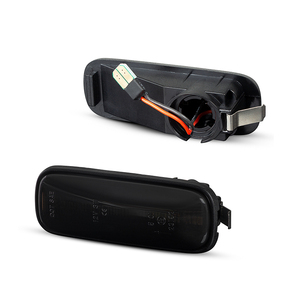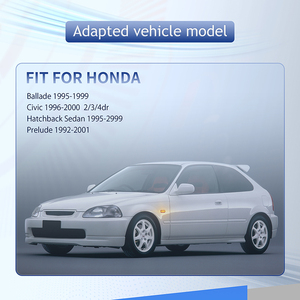
All categories
Featured selections
Trade Assurance
Buyer Central
Help Center
Get the app
Become a supplier

(18 products available)






































The 1996 Honda Civic tail lights, also known as the back lights or rear lights, are some of the significant lights located at the back of the 1996 Honda Civic vehicles. The return lights are important for the safety and visibility of the vehicles. However, the tail lights come in different types depending on the model of the Honda Civic. Here are some common types of the 1996 Honda Civic tail lights.
Honda Civic EX and DX models
These models have clear tail lights. The turn signals and the reverse lights are transparent. The brake lights have a red color that is in a circular shape. The lights are different from the original version because they give the car a more modern look.
Honda Civic LX model
The 1996 Honda Civic LX model tail lights are similar to the standard version. It has a design that is more rounded than the other models. The brake light uses red color lights. The turn signals are also red, but they use a lighter shade that is almost transparent. The reverse light is located in the middle and uses white light.
Honda Civic hatchback tail lights
The tail lights of the 1996 Honda Civic hatchback are more distinctive. They have a design that is angular and divided into two sections. Each section has its own light. The brake lights use red colors and are located on the outer side of each section. The turn signals and reverse lights are located on the inner sides. The turn signals use a yellow light, while the reverse lights are white.
Honda Civic coupe tail lights
The tail lights of the 1996 Honda Civic coupe are distinctive. They have a design that is more elongated and rounded than the other models. The brake lights are integrated into a single unit that also contains the turn signals. They both use red lights and are located on the outer side of the vehicle. The reverse lights are located on the inner side and use white lights.
Regular Cleaning
Dust, grime, and debris can accumulate on tail lights over time, diminishing their brightness. A mild car wash solution or soap and water should be used to clean the tail lights regularly. To avoid scratching the lens, use a soft cloth or sponge.
Bulb Inspection
The bulbs should be inspected periodically to ensure they are functioning properly. If any bulbs are found to be dimmer than others or have burned out, they should be replaced with new ones of the same type. This ensures uniform brightness.
Wiring Check
The wiring connections should be examined to ensure they are secure. Loose or corroded wires can cause flickering or complete failure of the tail lights. Any issues should be addressed by tightening connections or replacing damaged cables.
Lens Inspection
The lens covers should be inspected for cracks, cloudiness, or moisture buildup inside. Even small imperfections can reduce visibility. Damaged lenses should be replaced to maintain safety.
Polishing
Tail light lenses that have become dulled or yellowed over time can be restored with polishing compounds. These products remove surface imperfections and improve clarity.
Sealing
Water leaks around the edges of lenses allow moisture inside, which can damage bulbs and wiring. Flexible silicone sealants should be applied around any gaps to prevent infiltration.
Alignment
The tail lights should be checked to ensure they are properly aligned. Misalignment can lead to reduced effectiveness. The screws holding the lights in place should be adjusted as needed until they are facing straight back.
Professional Inspection
The tail lights should be inspected by a mechanic during regular maintenance appointments. Professionals have the tools to test bulb brightness, check for electrical issues, and thoroughly examine the entire lighting system.
Consider the Vehicle Compatibility
When selecting tail lights for any vehicle, it is essential to consider the car's make, model, and year. This information ensures that the lights fit perfectly without requiring modifications that could jeopardize their effectiveness. For instance, while shopping for a 1996 honda civic tail light, buyers need to be specific about the car's model to avoid mistakes that could lead to incompatible parts.
Style and Appearance
Tail lights play a crucial role in a vehicle's aesthetics. Therefore, when shopping for the lights, consider the color, shape, and design to ensure they match the car's style. Additionally, some styles stand out more than others, such as LED lights. They provide a modern look and are more efficient than conventional light bulb tail lights.
Brightness and Visibility
When choosing tail lights, prioritize clear and bright lights for optimal safety. The lights should be bright enough to alert drivers behind the vehicle, especially in poor weather conditions or at night. Additionally, the brightness should not interfere with the oncoming traffic by blinding them. Some tail lights have adjustable settings that allow users to set the brightness to their preference.
Legal Regulations
Before choosing tail lights, it is important to familiarize oneself with the local laws regarding vehicle lighting. Different regions have regulations on brightness levels, colors, and modifications allowed. Complying with these regulations is important to avoid fines and ensure safety.
Ease of Installation
While selecting tail lights, it is important to consider the ease of installing the lights. Some lights require complex installation that may need professional help, while others are DIY-friendly. Additionally, lights that are easy to install are cost-effective since they help avoid the extra cost of hiring a professional mechanic to install the lights.
Durability and Weather Resistance
When shopping for tail lights, buyers should select lights made from strong materials that can withstand harsh weather conditions. The lights should be resistant to extreme temperatures, heavy rains, and snow. Additionally, when selecting the lights, consider those that have seals and gaskets that prevent water and dust from entering the light housing, which could cause damage over time.
Price
Price is an important factor when choosing any product, including tail lights. Different brands and types of tail lights have varying prices. It is important to set a budget before shopping for the lights. However, do not compromise on quality. Tail lights with higher prices tend to provide better performance and durability than cheaper lights.
Warranty and Support
When choosing tail lights, consider lights that have a warranty. The warranty proves that the manufacturer trusts the quality of their product. Additionally, consider the tail light supplier's customer support. In case of any product failure, good customer support will help resolve the issue promptly.
Replacing tail lights on a Honda Civic is a straightforward process that can be done with basic tools. Here's a step-by-step guide on how to replace tail lights on a Honda Civic:
Replacing the tail lights on a Honda Civic is a simple process that can be completed in about 30 minutes to an hour, depending on the model year. If unsure about any step of the process, consult the vehicle's owner's manual or seek assistance from a qualified mechanic.
Q1: Will any 1996 honda civic tail light fit any honda civic?
A1: No, tail lights are designed to fit specific car models and years. However, some variations might fit with modifications.
Q2: Can one customize the tail lights for the 1996 Honda Civic?
A2: Yes, it is possible to customize the tail lights by using different types of light bulbs or adding unique elements, but the base unit must be compatible.
Q3: Are LED tail lights better than the standard tail lights for the 1996 Honda Civic?
A3: LED tail lights generally offer brighter illumination, longer lifespan, and lower energy consumption compared to standard tail lights.